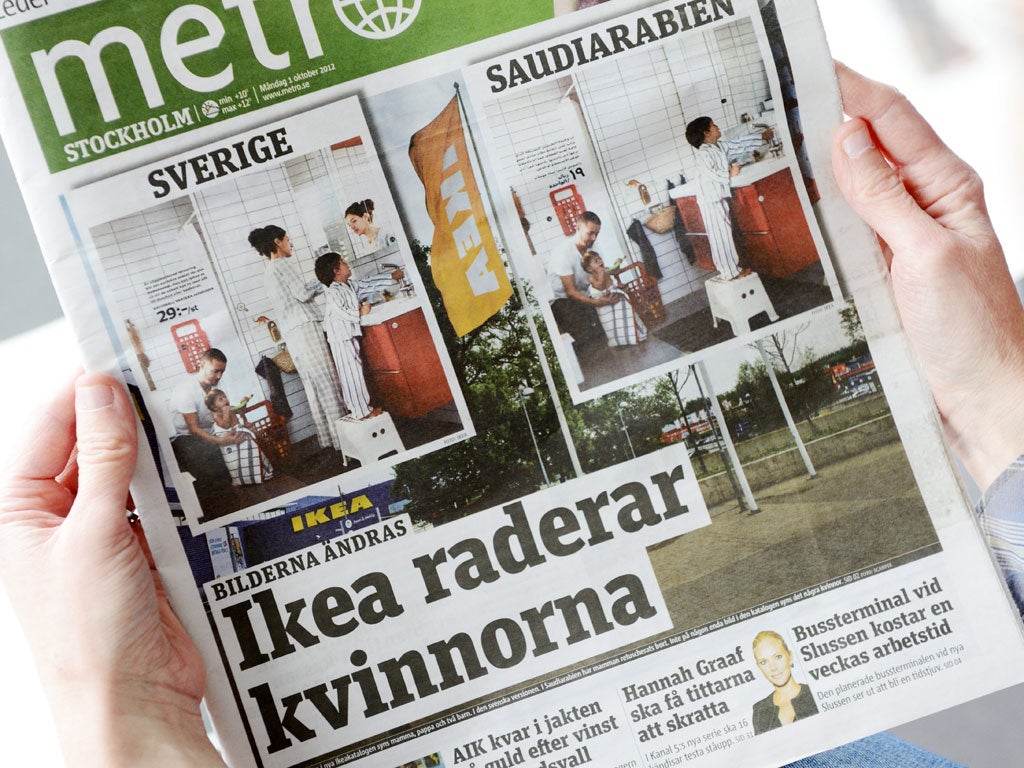Why exactly did Ikea remove pictures of women in its Saudi Arabia catalogue?
Commercial considerations led Ikea to omit women from its Saudi catalogue. But why does Saudi Arabia feel the need to "retouch" women from public life in the first place?


Your support helps us to tell the story
From reproductive rights to climate change to Big Tech, The Independent is on the ground when the story is developing. Whether it's investigating the financials of Elon Musk's pro-Trump PAC or producing our latest documentary, 'The A Word', which shines a light on the American women fighting for reproductive rights, we know how important it is to parse out the facts from the messaging.
At such a critical moment in US history, we need reporters on the ground. Your donation allows us to keep sending journalists to speak to both sides of the story.
The Independent is trusted by Americans across the entire political spectrum. And unlike many other quality news outlets, we choose not to lock Americans out of our reporting and analysis with paywalls. We believe quality journalism should be available to everyone, paid for by those who can afford it.
Your support makes all the difference.There is a crude Arabic expression which roughly translates as, ‘A man’s honour lies between a woman’s legs’. It was this kind of thinking which led to the purging of women from the Saudi edition of Ikea's catalogue.
Westerners, like the Swedish trade minister who denounced the catalogue, see this highly exaggerated concept of honour as detrimental to the rights of Saudi Arabian women. I agree. My parents lived in Saudi Arabia for over a decade, and developed a very dim view of women's rights in the country. My mother told me that nomadic mores presented difficulties for the women of her neighbourhood on every level from personal values to social mobility.
Non-muslims may be familiar with the Islamic buzzword ‘Wahabism’. This refers to the highly puritanical theology, endorsed by Saudi Arabia's religious status quo, which claims to be the most authentic and unsullied, living expression of Islam. One of its essential hallmarks is the belief that a woman’s presence should remain as awrah, or 'closed off from public view'. This is often used interchangeably with the Salafi teaching that a woman is not capable of entering a contract, and could only do so with guidance - or interference - from a male (this, despite the fact that the majority of Saudi Arabia’s graduates are female).
Of course, such sexist logic thwarts progressive attempts to have women’s interests represented in the civic realm. In order to maintain this gender hierarchy, Saudi men go to great lengths to remind their womenfolk that they are ultimately, inactive and dependent beings, incapable of any upward mobility or creative thinking. If any part of reality does not conform to this idealised trope, it would simply have to be discarded.
As unlikely as it may seen to Western feminists who have long associated domestic servitude with female oppression, Saudi culture objects to pictures of women in Ikea catalogues because of a niggling suspicion that such images would promote a degree of female self-determination. Not only would it contradict a woman’s role, which was not to be seen in the first place, but pictures of women, in any print medium, import ideas about reality from non-Wahabi sources, and were therefore rival systems of meaning. That in itself is enough to foster a looming fear of men losing their grip on society. It was not just another catalogue, but an agent of modernity.
What’s even more concerning is whether the future for women’s rights in Saudi Arabia can present any genuine grounds for optimism. Despite the Kingdom’s plan to enfranchise women by building a women-only city, the recent commotion over pictures suggest any reasonable measure of autonomy remains a distant fantasy. The problem is not simply that women are denied an unfettered right to divorce, or that their unauthorized exit from the home can lead to harsh reprisals. The problem is that as long as the discourse on Saudi women remains a conversation between Muslim puritans on the one hand, and western secularists on the other, Saudi women won't even be able to debate their own equality, let alone realise it.
The misappropriation of religion is often calculated precisely in order to bar women from access to the resources which could bring about equality. Any attempt, for example, from a Saudi woman’s group to engage NGOs and grassroots organisations in a conversation about women’s rights, would automatically be stifled by the top-down, clerical hierarchy, and accused of prioritising political reform over the ‘authentic’ sources of Islam - as unilaterally determined by some elect Sheikhs.
In the wake of the Arab Spring and amidst the ebb and flow of competing currents on women’s rights, the Saudis have yet to show a more liberal temperament on the women issue. Instead, they have resorted to flimsy pretexts and protectionist arguments to stifle liberties, which foreclose the possibility of placing discussions on gender on the agenda. This is just the latest episode in the Kingdom’s infamous track record of cultural gate-keeping. And it’s certainly not the last time we will hear Wahabis argue that their practice is the best guarantor of women’s rights.
Join our commenting forum
Join thought-provoking conversations, follow other Independent readers and see their replies
Comments